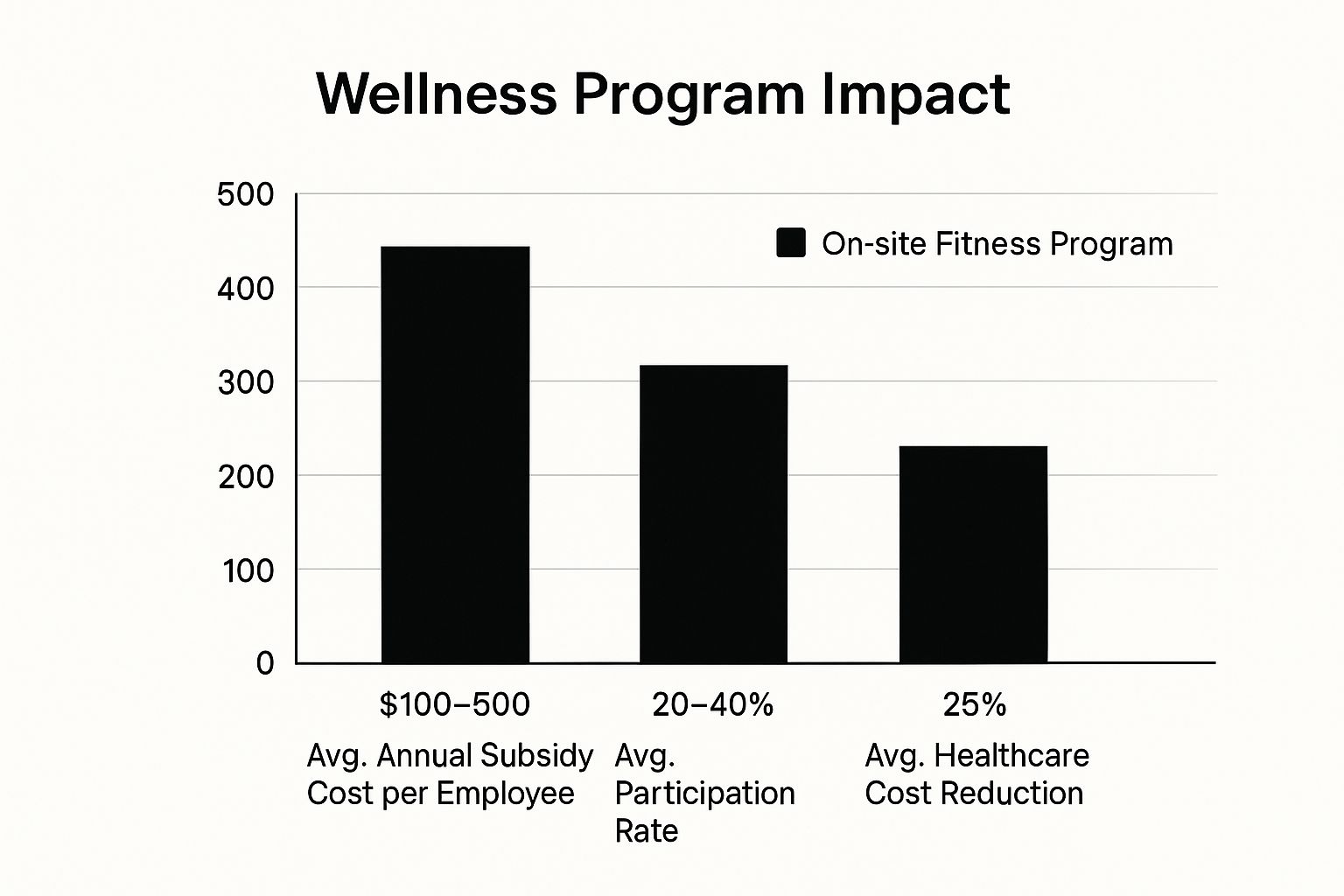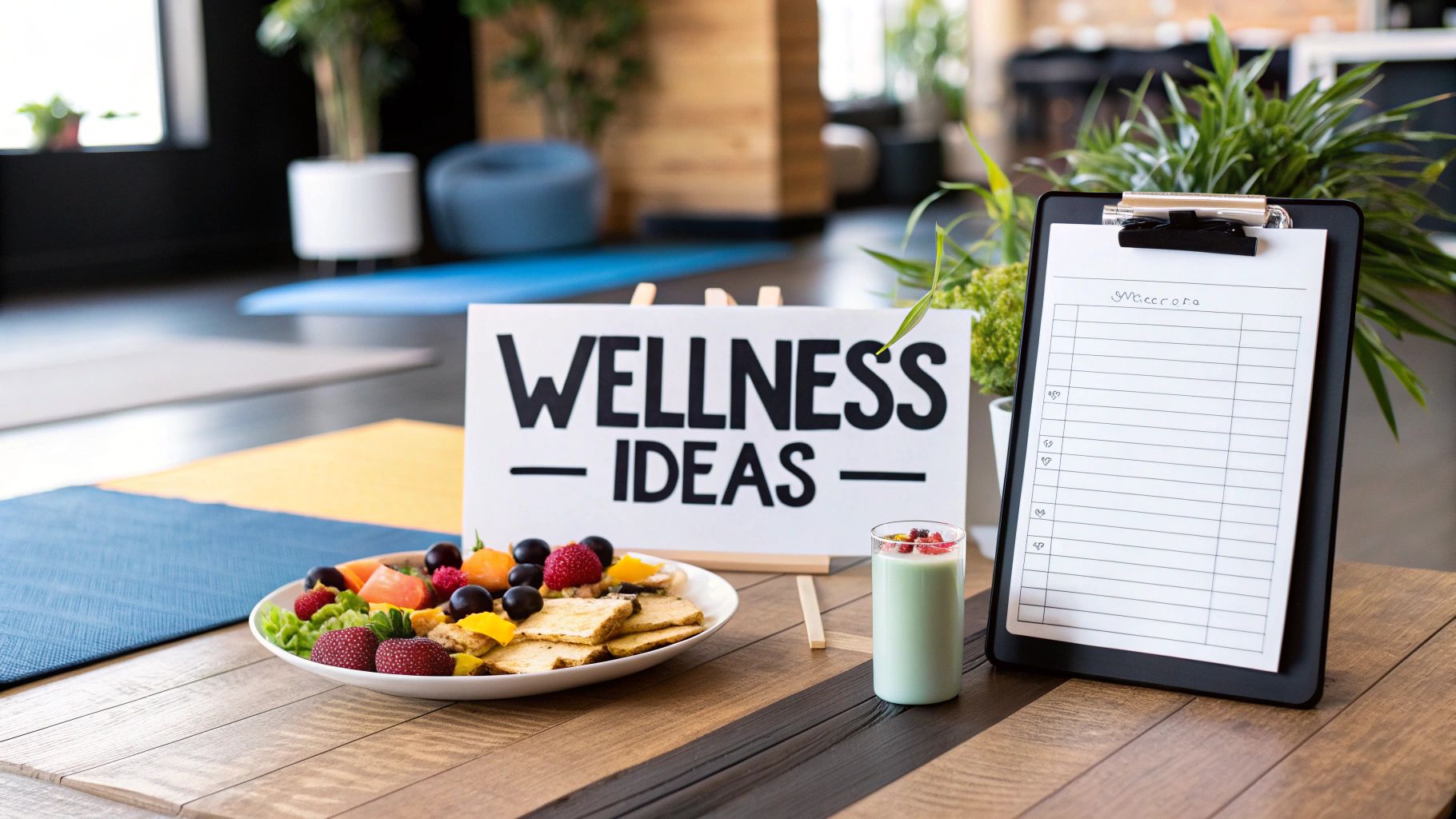In today's competitive landscape, attracting and retaining top talent requires more than just a competitive salary. A truly supportive work environment invests in the holistic wellbeing of its team. But generic wellness initiatives often fall flat, leading to low engagement and wasted resources. To create a lasting impact, companies must move beyond surface-level perks and implement thoughtful, comprehensive strategies.
This guide explores 10 powerful and practical workplace wellness program ideas designed to address the diverse needs of a modern workforce, from mental and financial health to physical and social wellbeing. We'll provide actionable steps, real-world examples, and fresh perspectives to help you build a program that genuinely enhances employee lives and drives organizational success. For those looking to dive even deeper into creative initiatives, you can explore these top employee wellness program ideas to supplement your strategy.
We'll also highlight how smart partnerships, like using a reliable catering service for wellness events, can simplify execution and elevate the employee experience. Forget the tired, uninspired approach; it's time to build a wellness culture that truly resonates with your team and delivers tangible benefits for everyone involved.
1. Mental Health Support and Counseling Programs
Comprehensive mental health support is a cornerstone of modern workplace wellness program ideas. These initiatives go beyond basic benefits by providing employees direct access to counselling services, therapy sessions, and stress management resources, often through an Employee Assistance Program (EAP). By addressing issues like anxiety, burnout, and work-life balance challenges with professional support, companies foster a psychologically safe and resilient workforce.

This proactive approach not only helps individual employees navigate personal and professional difficulties but also improves overall team morale, productivity, and retention.
Implementation Tips
- Partner with EAP Providers: Engage reputable EAP providers like ComPsych or Lyra Health to offer confidential, 24/7 support. Ensure their services are accessible and diverse, covering various needs.
- Promote Relentlessly and Confidentially: Regularly communicate the availability of these programs through multiple channels (email, intranet, team meetings). Emphasise that all services are 100% confidential to build trust and encourage participation.
- Empower Managers: Train managers to recognise signs of mental distress and guide team members toward available resources without overstepping professional boundaries.
- Offer Flexible Options: Provide a mix of support formats, including in-person sessions, video calls, and app-based resources. For teams seeking flexible and remote options, a comprehensive guide to online therapy services can be a valuable resource to share, empowering employees to find support that fits their lifestyle.
Catering Suggestion: Host a "Mindful Munchies" workshop featuring foods known to boost brain health, such as salmon, blueberries, nuts, and dark chocolate. Serve alongside calming herbal teas.
2. On-Site or Subsidised Fitness Programs
Integrating on-site or subsidised fitness programs is a powerful way to promote physical health within a company. These workplace wellness program ideas make regular exercise more accessible by offering resources like on-site gyms, group fitness classes, or discounted memberships to local facilities. By removing common barriers like cost and inconvenience, companies like Google and Asana encourage employees to build and maintain active lifestyles, directly improving their physical well-being.
This investment in physical wellness translates into tangible business benefits, including reduced absenteeism, higher energy levels, and improved focus, creating a more dynamic and productive work environment.
This bar chart visualises the direct financial and engagement impact of implementing a corporate fitness program.

The data clearly illustrates that a modest investment in subsidies can yield a significant reduction in healthcare costs while achieving a healthy participation rate.
Implementation Tips
- Start with Subsidies: Before committing to a full on-site facility, partner with platforms like Gympass or local fitness centres to offer subsidised memberships. This gauges interest and provides immediate value.
- Offer Diverse Options: Cater to all fitness levels and interests by providing a mix of activities, such as yoga, high-intensity interval training (HIIT), and strength-training classes.
- Schedule for Convenience: Hold classes during lunch hours or just before/after the workday to maximise attendance. Ensure facilities like showers are available for employee convenience.
- Foster Team Spirit: Create friendly wellness challenges or team-based fitness goals to boost engagement, morale, and accountability among colleagues.
Catering Suggestion: After a group workout session, provide a "Refuel Station" with protein-packed smoothies, Greek yogurt parfaits with granola, hard-boiled eggs, and fresh fruit platters to aid muscle recovery.
3. Flexible Work Arrangements and Work-Life Balance Initiatives
Offering flexible work arrangements is a powerful workplace wellness program idea that directly addresses the modern demand for better work-life integration. These initiatives include remote work, flexible hours, and compressed workweeks, giving employees greater autonomy over where and when they work. By trusting staff to manage their schedules, companies empower them to meet personal and professional responsibilities without sacrificing productivity or well-being.
This approach is proven to boost job satisfaction, reduce burnout, and attract top talent. Companies like Microsoft Japan famously saw a 40% productivity increase after testing a four-day workweek, demonstrating that flexibility can drive significant business results.
Implementation Tips
- Focus on Outcomes, Not Hours: Shift performance metrics from time spent at a desk to the quality and completion of work. This builds trust and encourages efficiency.
- Establish Clear Protocols: Document your flexible work policies, including communication expectations, core collaboration hours, and availability guidelines to ensure fairness and clarity for everyone.
- Equip for Success: Provide necessary technology, such as laptops and secure network access, and consider offering a stipend for home office setups to create an effective remote work environment.
- Train Your Leaders: Equip managers with the skills to lead remote and hybrid teams effectively. Training should focus on maintaining connection, managing performance remotely, and fostering an inclusive culture.
Catering Suggestion: Organise a "Build-Your-Own-Bowl" bar for in-office days. Offer healthy bases like quinoa and mixed greens, with a variety of proteins, vegetables, and dressings. This flexible meal option mirrors the autonomy of a flexible work schedule.
4. Nutrition and Healthy Eating Programs
Fueling the body with wholesome food is fundamental to employee energy, focus, and long-term health, making nutrition a vital component of workplace wellness program ideas. These initiatives focus on providing employees with access to healthy food options, nutritional education, and personalised dietary support. Companies like Google and Twitter, which offer free, organic, and nutritious meals, demonstrate how prioritising healthy eating can boost productivity and employee satisfaction.

By making healthy choices convenient and accessible, employers can significantly reduce health risks associated with poor diet, lower healthcare costs, and cultivate a culture where well-being is a shared value.
Implementation Tips
- Start Small and Build Momentum: Begin by introducing free fruit bowls or replacing vending machine junk food with healthier alternatives like nuts, yogurt, and granola bars.
- Partner for Freshness: Collaborate with local farms for a Community Supported Agriculture (CSA) box delivery or partner with healthy meal delivery services to offer employees discounted, pre-prepared lunches.
- Educate and Empower: Host "lunch-and-learn" workshops with registered dietitians to cover topics like meal prepping, reading nutrition labels, and mindful eating.
- Cater to All Needs: Ensure food offerings include diverse and clearly labelled options for various dietary requirements, such as vegan, gluten-free, and halal, to create an inclusive environment. Platforms like Foodsmart can help by providing telenutrition and healthy food delivery services tailored to individual needs.
Catering Suggestion: Organise a "Build-Your-Own-Bowl" bar with a base of quinoa or mixed greens, a variety of lean proteins (grilled chicken, chickpeas), fresh vegetables, and healthy fats like avocado and seeds. Offer light vinaigrette dressings.
5. Financial Wellness and Education Programs
Financial stress is a significant contributor to poor mental and physical health. Addressing this directly, financial wellness and education programs are essential workplace wellness program ideas that empower employees with the knowledge and tools to manage their finances effectively. These initiatives cover everything from budgeting and debt management to retirement planning and investing, helping reduce financial anxiety and build long-term security.
Companies like PwC have seen tangible results, reporting significant improvements in employee financial wellness scores after implementing comprehensive programs. This focus on financial health helps attract and retain talent by demonstrating a genuine investment in employees' overall well-being.
Implementation Tips
- Partner with Unbiased Experts: Collaborate with certified financial planners or reputable organisations to deliver workshops and one-on-one coaching. Ensure the advice provided is fiduciary-based and free from sales pressure.
- Cover Diverse Life Stages: Offer a range of topics relevant to different employee demographics, from student loan repayment assistance for recent graduates to estate planning for senior staff.
- Ensure Confidentiality: Create a safe, judgment-free environment for all financial wellness sessions. Emphasise that all personal financial discussions are 100% confidential to encourage honest participation.
- Provide Practical Tools: Supplement educational sessions with access to useful resources like budgeting apps, retirement calculators, or savings-matching programs to help employees put their learning into action.
Catering Suggestion: Host a "Lunch and Learn" financial workshop with a "Build-Your-Own-Budget Bowl" bar. Offer affordable and healthy bases like brown rice and quinoa, with various proteins and vegetable toppings, symbolising how to build a healthy financial plan from simple, smart components.
6. Preventive Health Screenings and Biometric Testing
Proactive health assessments are powerful workplace wellness program ideas that empower employees to take control of their physical well-being. These programs offer on-site or subsidized biometric testing, including blood pressure checks, cholesterol and glucose screenings, and BMI measurements. By providing accessible data and identifying potential health risks early, companies like Safeway and IBM have successfully encouraged preventive care behaviours, leading to healthier employees and reduced long-term healthcare costs.
This data-driven approach shifts the focus from reactive treatment to proactive prevention, fostering a culture where health is a shared priority and giving employees the tools they need to make informed lifestyle choices.
Implementation Tips
- Prioritise Confidentiality and Trust: Stress that all individual results are 100% confidential and are only shared directly with the employee. Use aggregate, anonymised data for program planning, never for individual evaluation.
- Partner with Reputable Vendors: Engage trusted health screening providers like Quest Diagnostics or Wellness Corporate Solutions to ensure professional and accurate testing.
- Incentivise, Don't Penalise: Encourage participation by offering rewards such as gift cards, extra paid time off, or wellness program points. Avoid penalties for non-participation, which can create resentment.
- Provide Immediate Follow-Up: Whenever possible, have health professionals on-site to interpret results immediately. Offer clear next steps and connect employees with resources or health coaching if their results indicate a potential risk.
Catering Suggestion: Host a "Know Your Numbers" breakfast bar following the screenings. Offer heart-healthy options like oatmeal with various toppings (berries, nuts, seeds), Greek yogurt parfaits, and whole-grain toast with avocado.
7. Stress Management and Mindfulness Programs
Introducing stress management and mindfulness initiatives is one of the most impactful workplace wellness program ideas for fostering mental resilience. These programs equip employees with practical tools like meditation, guided breathing exercises, and yoga to manage workplace pressures. By teaching evidence-based techniques for emotional regulation and focus, companies like Google with its "Search Inside Yourself" program and Aetna, which saw a 28% reduction in employee stress levels, have demonstrated the power of mindfulness.
This focus on mental fitness helps reduce burnout and improves cognitive functions like decision-making and creativity, creating a calmer and more productive work environment.
Implementation Tips
- Offer Accessible Starting Points: Provide corporate subscriptions to apps like Calm or Headspace for Work, which offer a low-barrier entry to mindfulness for beginners and experts alike.
- Create Designated Quiet Zones: Designate a specific room or area as a tech-free quiet space for meditation, reflection, or simply a moment of peace. Ensure it is respected and free from interruptions.
- Normalise Short Breaks: Encourage and lead brief, 5-minute mindfulness sessions or breathing exercises at the start of meetings to centre the team and improve focus.
- Empower Internal Champions: Identify and train enthusiastic employees to become mindfulness champions who can lead voluntary sessions, share resources, and model healthy stress management practices.
Catering Suggestion: Organise a "Zen Lunch" with calming, nourishing foods. Offer a build-your-own Buddha bowl bar with quinoa, roasted sweet potatoes, avocado, leafy greens, and a soothing lemon-tahini dressing. Serve with decaffeinated green tea or infused water.
8. Social Wellness and Team Building Activities
Social wellness programs are designed to strengthen workplace relationships, build community, and combat isolation. These initiatives foster connection through organised team activities, social events, and collaborative experiences, moving beyond day-to-day work tasks. By prioritising social bonds, companies like Zappos and Salesforce have built powerful cultures that enhance communication, teamwork, and overall organisational spirit.
Investing in these shared experiences is a key component of effective workplace wellness program ideas, leading to improved employee morale, a stronger sense of belonging, and a more positive and collaborative atmosphere.
Implementation Tips
- Offer Diverse and Inclusive Activities: Survey employees to discover their interests. Provide a variety of options, from sports leagues and book clubs to volunteer days and cooking classes, to appeal to different personalities.
- Schedule During Work Hours: To maximise participation and show that the company values social connection, integrate activities into the workday rather than making them after-hours obligations.
- Establish Employee Resource Groups (ERGs): Empower employees to create their own communities based on shared interests, backgrounds, or identities. Companies like Salesforce use "Ohana Groups" to foster organic connections.
- Keep it Optional and Low-Pressure: Ensure all social events are voluntary. This prevents them from feeling like a mandatory chore and allows genuine enthusiasm to drive engagement.
Catering Suggestion: Organise a "Build-Your-Own" team lunch, such as a taco bar, pizza station, or gourmet salad bar. This interactive format encourages conversation and collaboration while colleagues create their meals together.
9. Ergonomics and Workplace Safety Programs
Investing in ergonomics and workplace safety is a fundamental workplace wellness program idea that directly addresses the physical well-being of employees. These initiatives focus on designing workspaces that fit the worker, not forcing the worker to fit the workspace. This involves ergonomic assessments, adjustable furniture, proper equipment, and safety training to prevent musculoskeletal disorders, reduce physical strain, and minimize the risk of injury.
A proactive ergonomics program demonstrates a deep commitment to employee health, leading to fewer workers' compensation claims, reduced absenteeism, and improved focus. Companies like Microsoft, which provide comprehensive ergonomic assessments and equipment, see a direct impact on employee comfort and productivity.
Implementation Tips
- Conduct Professional Assessments: Hire a certified ergonomist to evaluate workstations for both in-office and remote employees, providing personalised recommendations.
- Invest in Adjustable Equipment: Provide adjustable chairs, sit-stand desks, and monitor arms that can be customised to fit individual body types and needs. Include home office stipends for remote workers.
- Organise Training Workshops: Regularly train employees on proper posture, workstation setup, and safe lifting techniques. Emphasise the importance of taking regular movement and stretch breaks.
- Create "Ergonomics Champions": Appoint and train volunteers within departments to be the go-to resource for basic ergonomic questions and to promote best practices among their peers.
Catering Suggestion: Host a "Bone-Building Buffet" during a safety seminar. Feature calcium-rich foods like yogurt parfaits, cheese platters, dark leafy green salads, and almond-based snacks to promote musculoskeletal health.
10. Sleep Wellness and Fatigue Management Programs
Recognizing that quality rest is fundamental to performance, sleep wellness and fatigue management programs are vital workplace wellness program ideas. These initiatives educate employees on healthy sleep hygiene and implement policies that combat workplace fatigue. By providing resources like sleep tracking tools, quiet rest areas, or even nap pods, companies like Google and Nike acknowledge sleep's direct impact on productivity, creativity, and safety.
This focus on rest helps prevent burnout and reduces the risks associated with sleep deprivation, such as decreased cognitive function and higher error rates, particularly for shift workers. It demonstrates a holistic commitment to employee well-being that extends beyond the office walls.
Implementation Tips
- Educate and Destigmatize: Start by hosting workshops led by sleep specialists to educate staff on the critical role of sleep. Normalise conversations about sleep challenges to create a supportive culture.
- Establish "Right to Disconnect" Policies: Create clear guidelines that limit after-hours emails and calls, allowing employees to fully unplug and recharge.
- Provide Quiet Spaces: Designate a room for quiet rest, meditation, or even brief naps. This provides a sanctuary for employees to de-stress and recover during the day.
- Optimise Shift Schedules: For roles requiring non-traditional hours, review and adjust schedules to better align with natural circadian rhythms, reducing the health risks associated with shift work.
Catering Suggestion: Organise a "Wind-Down Workshop" with a menu featuring sleep-promoting foods. Serve small portions of turkey pinwheels (tryptophan), tart cherry juice, chamomile tea, and almond-based snacks.
Workplace Wellness Program Ideas Comparison
| Program | Implementation Complexity | Resource Requirements | Expected Outcomes | Ideal Use Cases | Key Advantages |
|---|---|---|---|---|---|
| Mental Health Support and Counseling Programs | Moderate (2-3 months) | Moderate cost ($50-$150 per employee annually), professional counselors, ongoing communication | Reduced absenteeism, improved retention, early intervention, +12-15% productivity | Organizations prioritizing mental health, need for crisis support | Professional support, confidentiality, stigma reduction |
| On-Site or Subsidized Fitness Programs | High for on-site (6-12 months); Low for subsidies (1-2 months) | High cost ($100-$500 per employee subsidies; $50,000+ for facilities), equipment, trainers | Reduced healthcare costs (-25%), improved morale, energy, team bonding | Companies with space/resources for facilities, promoting physical health | Convenient access, team engagement, health cost savings |
| Flexible Work Arrangements and Work-Life Balance Initiatives | Low to moderate (1-3 months) | Minimal monetary cost, technology infrastructure, management training | Improved retention (+25-30%), stress reduction, +13-35% productivity | Companies supporting remote/hybrid work or flexible schedules | Employee autonomy, talent attraction, overhead cost savings |
| Nutrition and Healthy Eating Programs | Low to moderate (1-3 months) | Moderate to high cost ($200-$1,000+ per employee annually), food vendors, nutrition staff | Reduced chronic disease risk, better energy, cognitive function | Organizations focusing on dietary health and chronic disease prevention | Supports weight management, improves team culture |
| Financial Wellness and Education Programs | Low (1-2 months) | Low to moderate cost ($50-$200 per employee annually), financial advisors | Reduced financial stress, improved focus, enhanced recruitment | Companies targeting financial literacy and reducing financial stress | High perceived value, supports retirement readiness |
| Preventive Health Screenings and Biometric Testing | Moderate (2-3 months) | Moderate cost ($50-$150 per screening), medical vendor partnerships | Early risk detection, health awareness, reduced premiums | Organizations focused on proactive health management | Early identification, on-site convenience, data-driven programs |
| Stress Management and Mindfulness Programs | Low (1 month) | Low cost ($10-$50 per employee annually for apps; workshops $500-$2,000) | Reduced stress, improved focus, decreased burnout | Companies aiming to reduce workplace stress affordably | Scientific backing, low cost, broad appeal |
| Social Wellness and Team Building Activities | Ongoing (1 month initial setup) | Variable cost ($50-$500+ per employee annually), event planning | Improved communication, engagement, reduced isolation | Teams needing stronger relationships and culture building | Enhances belonging, supports remote workers |
| Ergonomics and Workplace Safety Programs | Moderate to high (3-6 months) | High cost ($200-$2,000 per employee + assessments $150-$300), ergonomic equipment | Injury prevention, reduced compensation claims, improved comfort | Workplaces with physical strain risks or compliance needs | Reduces injuries, OSHA compliance, ROI in 2-3 years |
| Sleep Wellness and Fatigue Management Programs | Low (1-2 months) | Low to moderate cost ($20-$100 per employee annually; nap rooms $3,000-$15,000) | Improved cognitive function, reduced accidents, +13-15% productivity | Companies addressing fatigue and shift work challenges | Addresses root cause of productivity loss, low cost |
Building a Culture of Wellness, One Step at a Time
We've explored a comprehensive list of workplace wellness program ideas, from mental health support and on-site fitness to financial education and ergonomic assessments. Each initiative offers a unique opportunity to support your team's holistic wellbeing. The central theme connecting all these concepts is that true wellness is multifaceted, touching every aspect of an employee's professional and personal life.
The most successful programs are not built overnight. They are cultivated through a deliberate and thoughtful process that prioritises employee needs and feedback. Remember, the goal isn't to implement every idea on this list simultaneously. Instead, it's about making a strategic, meaningful start that resonates with your unique organisational culture and workforce.
Key Takeaways for Lasting Impact
To transform these ideas into a thriving wellness culture, focus on these core principles:
- Listen First: Before launching any program, survey your employees. Understanding their specific needs, preferences, and pain points is the most critical step in designing initiatives that will actually be used and appreciated.
- Start Small, Execute Flawlessly: Choose one or two high-impact programs that align with your company’s resources and your team’s expressed needs. A perfectly executed mindfulness workshop or a well-organised nutrition seminar will build more momentum than a dozen poorly planned initiatives.
- Consistency is Crucial: Wellness is a continuous journey, not a one-time event. Whether it’s a weekly yoga class or a monthly financial literacy lunch-and-learn, consistency reinforces your commitment and keeps wellbeing top-of-mind for everyone.
Your Actionable Next Steps
Embarking on this journey is simpler than it seems. Begin by forming a small wellness committee with representatives from different departments to gather diverse perspectives. Use their insights to select a pilot program from the ideas discussed, such as a stress management workshop or a team-building activity focused on social wellness.
As you plan these events, consider how you can elevate the experience and reinforce the message of health. Partnering with a reliable caterer for your wellness events removes logistical stress and ensures the food perfectly complements your program's goals. Providing nourishing, delicious meals demonstrates your commitment in a tangible way, making employees feel genuinely cared for and valued. By investing thoughtfully in your team's wellbeing, you are not just boosting morale or productivity; you are building a more resilient, engaged, and successful organisation for the long term.
Ready to fuel your next wellness event with food that's as healthy as it is delicious? Let Shawarma Moose handle the catering with our diverse menu of fresh, flavourful, and customisable options that cater to every dietary need. Visit Shawarma Moose to see how we can make your workplace wellness initiatives a memorable success.

